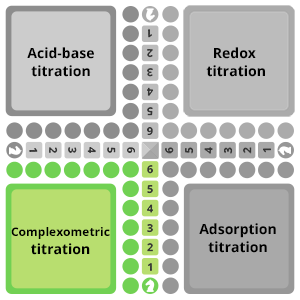Complexometric titration
In a complexometric titration, a colored indicator Ind is added to the solution we wish to analyze. The indicator is capable of creating a colored complex Eint -Ind(aq) with the analyte of interest (1), with a different color from that of the indicator Ind (aq) alone in solution under the titration conditions.
(1) E int(aq) + Ind(aq) = Eint - Ind(aq)
As with acid-base indicators and redox indicators, care must be taken not to add too much so that most of the analyte of interest remains free (uncomplexed) in solution.
The titrant T is chosen in order to form a complex Eint -T (aq) with the analyte of interest and so that: Its formation is more likely to occur than the previously formed complex Eint -Ind(aq); Its color in solution is different from that of Eint -Ind(aq): ideally colorless.
During titration, Eint -Ind(aq) complexes are first formed with the free analyte of interest (2) and then reacted with Eint -Ind(aq) (3). The indicator Ind is released and the solution changes to a characteristic color (different from that of Eint -Ind(aq) ) specific to Ind (aq).
(2) E int(aq) + T(aq) = Eint -T (aq)
(3) Eint -Ind(aq) + T(aq) = Eint -T (aq) + Ind (aq)

An example of colorimetric complexometric titration is the determination of water hardness.





